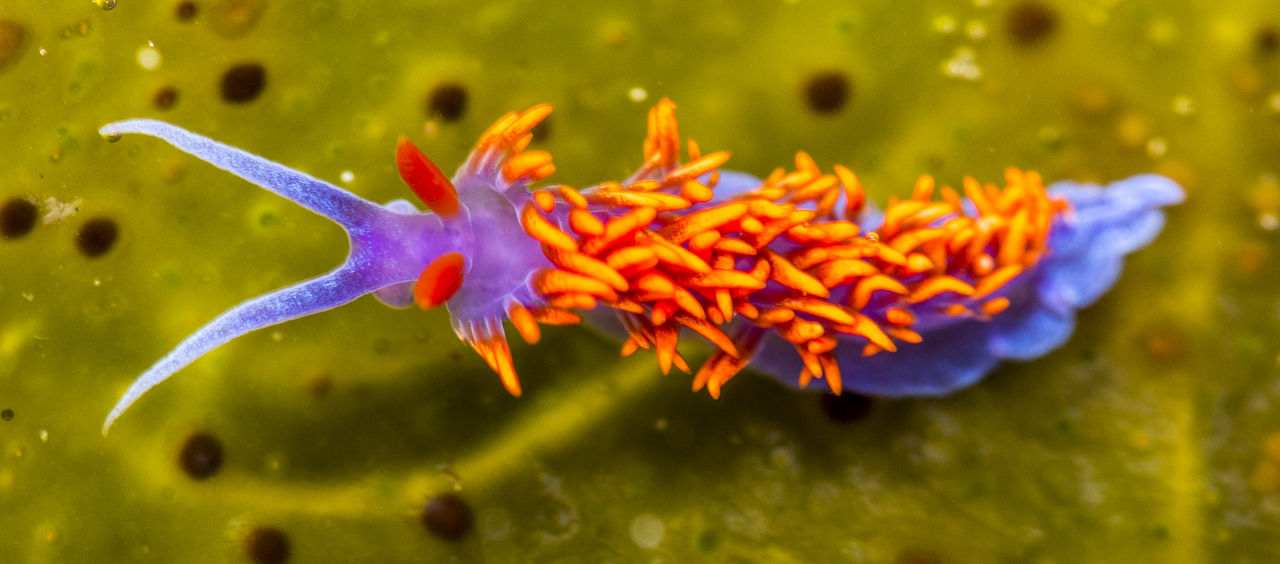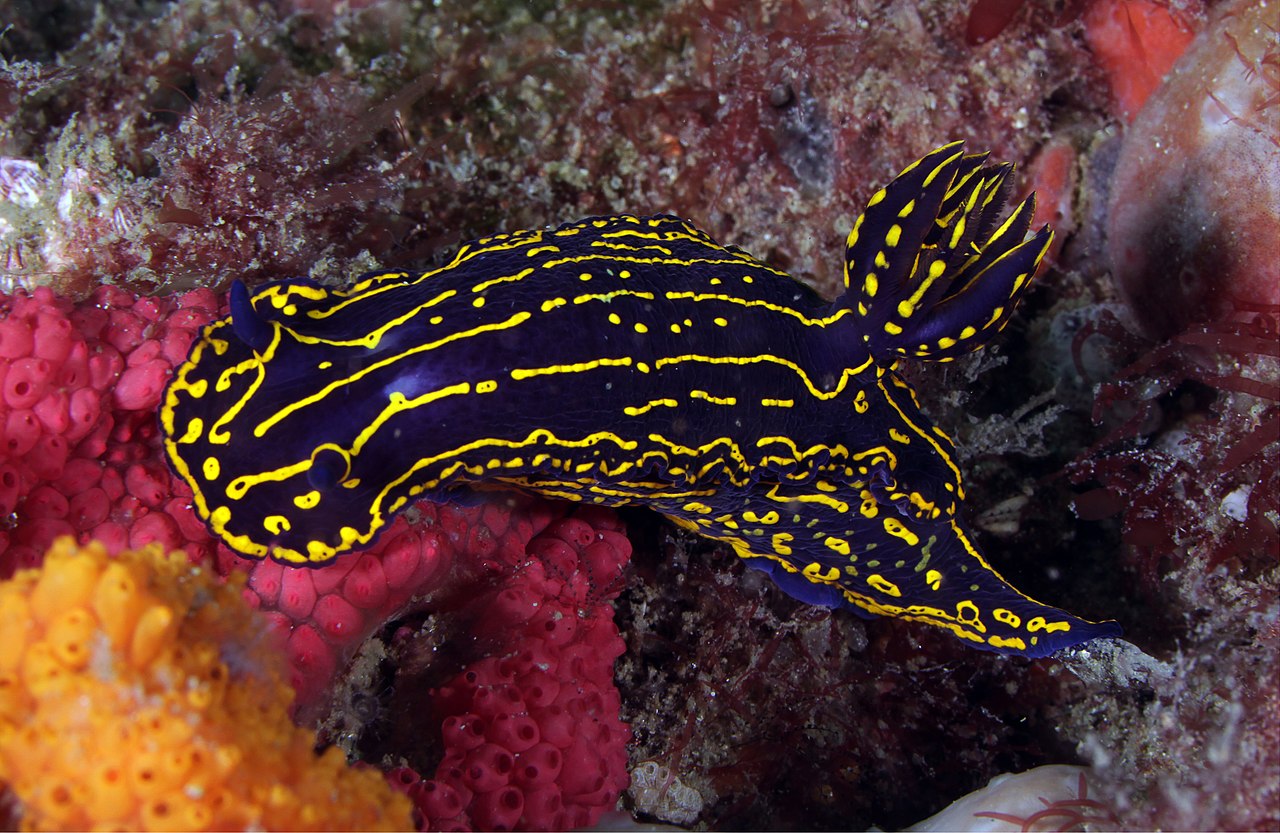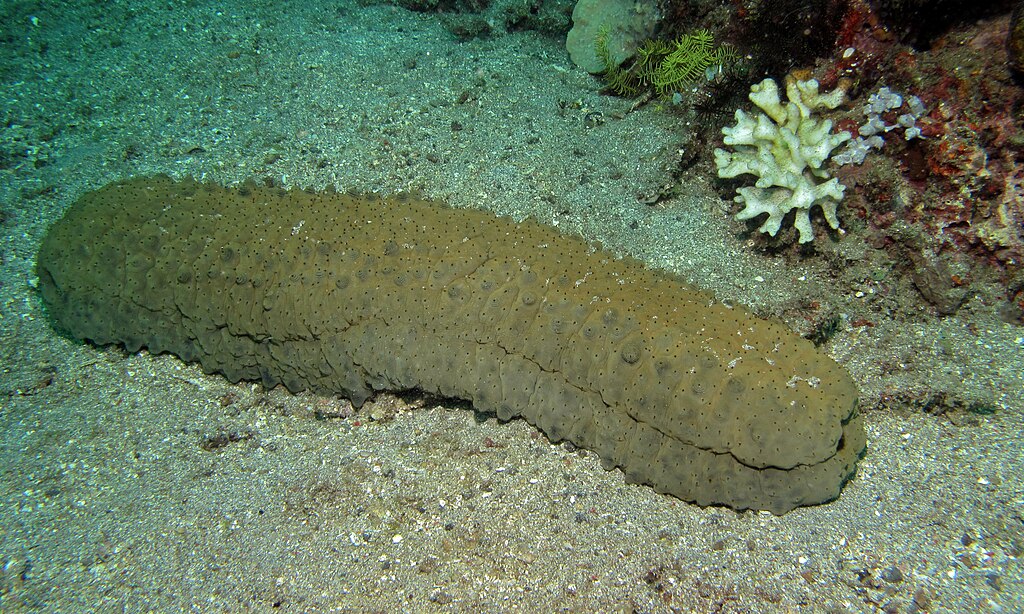Molluscs, Echinoderms, and Invertebrate Chordates:
- Unsegmented soft body with bilateral symmetry.
- Presence of an internal or external shell.
- A toothed tongue (made mostly of chitin) called the radula.
- A mantle which is a fold in the body wall that lines the shell.
- Muscular foot (and/or tentacles in some).
- Possession of a fluid-filled cavity called coelom.
 |
| Preserved chitons in a jar. |
Mollusca have three regions of their body: the head-foot region, the visceral mass, and the mantle. The head-foot region has their sensory and motor organs and the visceral mass contains their internal organs, including the reproductive system. The mantle is a specialized tissue that surrounds the visceral mass, it secretes the shell and helps develop the organs used to breathe.
Chiton:
Chitons are a mollusk that live in the rocks mainly in shallow waters. They have eight plates on their shell, or valves, which allow them the flexibility to move across the uneven rocks and protection from any predators. The come from the class Polyplacophora which translate into "bearer of many plates," their plates are flattened from their back to front with complex set of muscles in-between plates.
Sea snails are mollusks from the class Gastropoda which is a very diverse group with many different species in a wide range of habitats. They live inside a shell that is attached to their body by muscle and grows as the snail grows. Snails can pull their body inside of the shell fully while resting or to protect itself from a predator. They move about by using its foot, a muscular structure that expands and contracts to move forward. There is a mucus that is secreted from the snails skin which helps them to move by lubricating the surface beneath them.
 |
| Image of the anatomy of a snail. By Original by Al2, edits by Jeff Dahl CC BY-SA 4.0. |
Nudibranchs are also in the class Gastropoda along with the sea snails but a big difference between the two is that nudibranchs do not have shells, or if they do it is very small. They also have exposed gills located on their backs. Since they do not have shells to protect themselves they use other forms of defense mechanisms such as chemical defenses and camouflage. Typically, the nudibranchs do not produce their own chemical defenses but instead get them from their food sources such as sponges. Sponges will sometimes have poisonous chemical in their tissues which the nudibranchs can reuse mixed with their own to deter from being eaten. Their bright colorings are also key to warn predators of toxicity. Since nudibranchs are slow moving, they spend a lot of their time on what they prey on and can incorporate the color of that animal into their own tissue making them camouflaged. The photographs below are of two different species of nudibranchs. The first one is of the Spanish Shawl which its bright coloring and spikes warns predators not to eat them. The next picture is of the Regal Sea Goddess, whose dark coloring with bright yellow stripes and spots can help it with both warning predators and with camouflage.
 |
| Spanish Shawl Nudibranch. By Jerry Kirkhart, CC BY 2.0 |
 |
| Regal Sea Goddess Nudibranch. By Greg McFall, Public Domain |
Bivalve shells refers to mollusks that have a 2-valved hinged shell such as a clam or scallop. Mollusks shells are made out of mainly calcium carbonate, not made up out of cells like most animal structures are. These shells are not shed, instead they grow as the organism within grows.
Clams:
- Function of the mantle: The mantle functions to protect the bivalve's body on both sides, the space in-between is called the mantle cavity. The mantle is folded into three folds on the outer rim. The fold that is the farthest outside of the organism produces cells that make the shell, the middle one is used for sensory tasks, and the fold on the inside regulates the water flow that goes in and out of the mantle cavity.
- Function of the foot: The foot is how the mollusks move. Its shape has adapted to how the mollusk lives, for example, mussels that swim or those that are sessile have a reduced foot.
- Function of the adductor muscles: Typically in mollusks there are two adductor muscles but in some species it has adapted to only needing one. They function to hold the shell tightly closed when they contract.
function of mantle adductor muscles and foot
| Diagram of the internal anatomy of a clam. Modified from Cesari and Pellizzato, 1990. |
Octopi are a in the class Cephalopoda which means "head-footed." While they do not look closely related to mollusks on the outside, internally their constructions are very similar to one another. Some similarities between the two are the presence of a mantle and mantle cavity, a radula in the mouth, and a U-shaped digestive tract. A big difference is that the octopus does not have a shell, also they have a much more developed nervous system along with a very developed eye. Lastly, octopi have 8 tentacles which they use to move and to bring food to their beak to eat.
Major characteristics of Echinoderms:
1. Larval form shows bilateral symmetry and adult forms show radial symmetry.
2. They are triploblastic; having body tissues with three basic cellular layers, the ectoderm, the endoderm, and the mesoderm.
3. They have a true coelom.
4. An unsegmented body without a head.
5. Calcareous spicules covering the bodies surface.
6. Tube feet to help in locomotion
7. Absent brain, but a present nervous system.
8. Sexes are separate and fertilization is external.
Major characteristics of Echinoderms:
1. Larval form shows bilateral symmetry and adult forms show radial symmetry.
2. They are triploblastic; having body tissues with three basic cellular layers, the ectoderm, the endoderm, and the mesoderm.
3. They have a true coelom.
4. An unsegmented body without a head.
5. Calcareous spicules covering the bodies surface.
6. Tube feet to help in locomotion
7. Absent brain, but a present nervous system.
8. Sexes are separate and fertilization is external.
 |
| Image of the underneath of a starfish. |
 |
| Top of the starfish. |
 |
| Close up of the starfish's mouth under a dissecting scope. |
Sea Star: Sea stars have tube feet which are tentacle-like structures with suction cups at the ends. They are controlled hydraulically by their vascular system that supplies water through muscular tubes to the feet. As the starfish go to move, the tube feet press against the surface beneath them and water is withdrawn to create a suction to stay attached. When water flows through the muscular tubes again the suction is then released. This process of locomotion is fairly slow.
Sea Urchins: While sea urchins may look very different from sea stars, they actually come from the same phylum, Echinodermata. Both species have an outer hard body, even though the sea urchins is hard to spot under all of its spines. The sea urchins outer skeleton is called a test, it is made out of ten plates fused together that encircle the body like an orange peel. It is through every other section that there is holes for it to extent its tubed feet which is how it is able to move feet. When the urchin dies all of the spines fall off, leaving only the test. Sand dollars are actually the skeletons of a certain type of sea urchin.
 |
| Sea Cucumber by Bernard DUPONT. CC BY-SA 2.0. |
Sea Cucumber: Sea cucumbers are also echinoderms like starfish and sea urchins. Sea cucumbers have a cucumber shaped body with tube feet that they use to walk around and feed themselves with. They also can diffuse their internal toxic organs from their bodies to harm their predators but, they are able to grow these organs back like how starfish can if they loose a tentacle.
Four Basic Structures that are Characteristic of the Phylum Chordata:
1. a notochord: provides skeletal support
2. a dorsal hollow nerve cord: develops into the brain and spinal cord
3. pharyngeal slits: the openings in the pharynx that extent to the outside environment.
4. post-anal tail: used for locomotion
| Diagram of a tunicate. |
Tunicates: Tunicates are also called sea squirts. They are built like a barrel, their name coming from their firm but flexible body covering called a tunic. They are plankton feeders, drawing in water from their oral siphon where it travels through a sieve-like structure where the branchial basket traps the food and oxygen and the excess water goes out through the atrial siphon.

Comments
Post a Comment